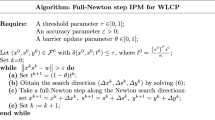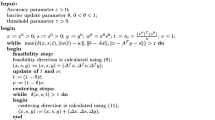Abstract
The paper is concerned with methods for solving linear complementarity problems (LCP) that are monotone or at least sufficient in the sense of Cottle, Pang and Venkateswaran (1989). A basic concept of interior-point-methods is the concept of (perhaps weighted) feasible or infeasible interior-point paths. They converge to a solution of the LCP if a natural path parameter, usually the current duality gap, tends to 0.
After reviewing some basic analyticity properties of these paths it is shown how these properties can be used to devise also long-step path-following methods (and not only predictor–corrector type methods) for which the duality gap converges Q-superlinearly to 0 with an arbitrarily high order.
Similar content being viewed by others
References
W. Cottle, J.-S. Pang and V. Venkateswaran, Sufficient matrices and the linear complementarity problem, Linear Algebra Appl. 114/115 (1989) 231–249.
M. Kojima, N. Megiddo and S. Mizuno, A primal-dual infeasible-interior-point algorithm for linear programming, Math. Programming Series A 61 (1993) 263–280.
M. Kojima, N. Megiddo, T. Noma and A.Yoshise, A Unified Approach to Interior Point Algorithms for Linear Complementarity Problems (Springer, 1991).
M. Kojima, S. Mizuno and T. Noma, Limiting behavior of trajectories generated by a continuation method for monotone complementarity problems, Mathematics of Operations Research 15 (1990) 662–675.
S.Mizuno, F. Jarre and J. Stoer, A unified approach to infeasible-interior-point algorithms via geometrical linear complementarity problems, J. Appl. Math. Optim. 13 (1996) 315–341.
R.D.C. Monteiro and T. Tsuchyia, Limiting behavior of the derivatives of certain trajectories associated with a monotone horizontal linear complementarity problem, Mathematics of Operations Research 21 (1996) 793–814.
J. Stoer, Improved high order long-step methods for solving linear complementarity problems, Technical report 237, Institut für Angewandte Mathematik und Statistik, Universität Würzburg, Würzburg, Germany (1999).
J. Stoer and M. Wechs, Infeasible-interior-paths for sufficient linear complementarity problems and their analyticity, Math. Programming 83 (1998) 407–423.
J. Stoer, M. Wechs and S. Mizuno, High order infeasible-interior-point methods for solving sufficient linear complementarity problems, Mathematics of Operations Research 23 (1998) 832–862.
H. Väliaho, P *-matrices are just sufficient, Linear Algebra Appl. 239 (1996) 103–108.
S.J. Wright, A path-following interior-point algorithm for linear and quadratic problems, Annals of Operations Research 62 (1996) 103–130.
S.J. Wright: Primal-Dual Interior-Point Methods (SIAM, 1997).
G. Zhao and J. Sun, On the rates of local convergence of high-order-infeasible-path-following algorithms for P *-LCP with or without strictly complementary solutions, Computational Optimization and Applications 14 (1999) 293–307.
Author information
Authors and Affiliations
Rights and permissions
About this article
Cite this article
Stoer, J. High Order Long-Step Methods for Solving Linear Complementarity Problems. Annals of Operations Research 103, 149–159 (2001). https://doi.org/10.1023/A:1012951021320
Issue Date:
DOI: https://doi.org/10.1023/A:1012951021320




